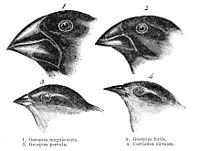
Photo from wikipedia
Traditional phylogenies inferred from chloroplast DNA fragments have not obtained a well-resolved evolutionary history for the backbone of Apioideae, the largest subfamily of Apiaceae. In this study, we applied the… Click to show full abstract
Traditional phylogenies inferred from chloroplast DNA fragments have not obtained a well-resolved evolutionary history for the backbone of Apioideae, the largest subfamily of Apiaceae. In this study, we applied the genome skimming approach of next-generation sequencing to address whether the lack of resolution at the tip of the Apioideae phylogenetic tree is due to limited information loci or the footprint of ancient radiation. A total of 90 complete chloroplast genomes (including 23 newly sequenced genomes and covering 20 major clades of Apioideae) were analyzed (RAxML and MrBayes) to provide a phylogenomic reconstruction of Apioideae. Dating analysis was also implemented using BEAST to estimate the origin and divergence time of the major clades. As a result, the early divergences of Apioideae have been clarified but the relationship among its distally branching clades (Group A) was only partially resolved, with short internal branches pointing to an ancient radiation scenario. Four major clades, Tordyliinae I, Pimpinelleae I, Apieae and Coriandreae, were hypothesized to have originated from chloroplast capture events induced by early hybridization according to the incongruence between chloroplast-based and nrDNA-based phylogenetic trees. Furthermore, the variable and nested distribution of junction positions of LSC (Large single copy region) and IRB (inverted repeat region B) in Group A may reflect incomplete lineage sorting within this group, which possibly contributed to the unclear phylogenetic relationships among these clades inferred from plastome data. Molecular clock analysis revealed the chloroplast capture events mainly occurred during the middle to late Miocene, providing a geological and climate context for the evolution of Apioideae.
Journal Title: Molecular phylogenetics and evolution
Year Published: 2021
Link to full text (if available)
Share on Social Media: Sign Up to like & get
recommendations!